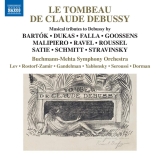 Le Tombeau de Claude Debussy 1920 (Sammlung von Klavierstücken von Dukas, Falla, Schmitt, Satie, Malipiero, Stravinsky, Goossens, Bartok, Roussel zu Ehren Claude Debussys); Ravel: Sonate für Violine & Cello; Stravinsky: Symphonie für Bläser; Falla: Homenaje für Gitarre; Tomer Lev, Klavier, Sharon Rostorf-Zamir, Janna Gandelman, Dmitry Yablonsky, Ruben Seroussi, Buchmann-Mehta Symphony Orchestra, Zeev Dorman; 1 CD Naxos 8.573935; Aufnahme 2017-2020, Veröffentlichung 01/2021 (63'44) – Rezension von Nobert Tischer
Le Tombeau de Claude Debussy 1920 (Sammlung von Klavierstücken von Dukas, Falla, Schmitt, Satie, Malipiero, Stravinsky, Goossens, Bartok, Roussel zu Ehren Claude Debussys); Ravel: Sonate für Violine & Cello; Stravinsky: Symphonie für Bläser; Falla: Homenaje für Gitarre; Tomer Lev, Klavier, Sharon Rostorf-Zamir, Janna Gandelman, Dmitry Yablonsky, Ruben Seroussi, Buchmann-Mehta Symphony Orchestra, Zeev Dorman; 1 CD Naxos 8.573935; Aufnahme 2017-2020, Veröffentlichung 01/2021 (63'44) – Rezension von Nobert Tischer

Le Tombeau de Claude Debussy ist ein kollektives Werk, das 1920 von Henry Prunières, dem Direktor der Pariser Revue Musicale, in Auftrag gegeben wurde. Es besteht aus zehn Stücken: sechs Stücke für Klavier solo (von Paul Dukas, Albert Roussel, Gian Francesco Malipiero, Eugène Goossens, Bela Bartok und Florent Schmitt), ein Stück für Gitarre von Manuel de Falla, ein Stück für Violine und Cello von Maurice Ravel (ein Satz seiner Sonate), eine Melodie von Erik Satie und ein Klavierauszug aus Igor Strawinskys Symphonien für Blasinstrumente.
« Jeder von ihnen würdigte den verstorbenen Meister in seinem typischen Stil und reflektierte gleichzeitig Debussys Ästhetik, wodurch eine Art musikalische Zeitkapsel von Paris in dieser einzigartigen historischen Periode entstand », schreibt der Initiator dieser CD, der israelische Pianist und Pädagoge Tomer Lev. Er ist Direktor der hier involvierten Buchmann-Mehta School of Music.
Naxos legt damit, wie es heißt, die erste Gesamtaufnahme der vollständigen Originalfassung vor, angereichert mit verwandten Werken.
Tomer Lev sagt: « Sehr schnell entdeckte ich auch den Grund, warum dieses Stück nicht aufgeführt wird und nicht in das Konzertrepertoire aufgenommen wurde. Nicht, dass es kein wichtiges Stück Geschichte wäre, denn es stellt einen einzigartigen Querschnitt durch das musikalische Paris dar, gerade als eine Generation von Komponisten den Taktstock an eine andere übergab. Es war nicht so, dass es musikalisch nicht funktioniert hätte – ganz im Gegenteil. Nein, es liegt daran, dass Le Tombeau in der Praxis so gut wie nicht aufführbar ist. Da den Komponisten keine genauen Kriterien vorgegeben wurden, konnten sie ihrer Fantasie freien Lauf lassen und für eine schwindelerregende Vielfalt an Besetzungen komponieren. Und welche musikalische Institution könnte schon ein Solo-Klavier, eine Sopranistin, eine Gitarre, eine Violine und ein Cello aufbieten, geschweige denn ein Orchester mit 23 Bläsern? (Eine kurze Klarstellung zu diesem ‘Orchester’: Strawinskys Stück stammt aus den längeren und orchestralen Symphonies Of Wind Instruments, an denen er gleichzeitig arbeitete, aber obwohl das, was er der Zeitschrift gab, ein Klavierarrangement war, habe ich immer geglaubt, dass es nur in seiner fertigen orchestralen Vision funktioniert und dass dies das ist, was Strawinsky im Sinn hatte). »
Mit dieser CD hat Tomer Lev einen Traum verwirklicht. Seine textlich festgehaltene Begeisterung kann ich musikalisch nicht ganz nachvollziehen, sind die Interpretationen doch etwas akademisch geraten, und es fehlt ihnen das französische Flair. Die Musik wird allerdings auch sehr sorgfältig und auf gutem Niveau gespielt und das macht die CD zu einem doch wichtigen Tondokument.
Le Tombeau de Claude Debussy is a collective work commissioned in 1920 by Henry Prunières, director of the Revue Musicale, and premiered the following year. It consists of ten pieces: six pieces for solo piano (by Paul Dukas, Albert Roussel, Gian Francesco Malipiero, Eugène Goossens, Béla Bartók and Florent Schmitt), a piece for guitar by Manuel de Falla, a piece for violin and cello by Maurice Ravel (in fact a part from his Sonata), a melody by Erik Satie and a piano excerpt from Igor Stravinsky’s Symphonies for Wind Instruments.
« Each of them paid tribute to the late master in his signature style while reflecting Debussy’s aesthetic, creating a kind of musical time capsule of Paris in this unique historical period, » writes the initiator of this CD, Israeli pianist and educator Tomer Lev, who is director of the Buchmann-Mehta School of Music involved here.
Naxos thus presents, as it says, the first complete recording of the complete original version, enriched with related works.
Tomer Lev says, « Very quickly I also discovered the reason why this piece is not performed and did not become part of the concert repertory. It wasn’t that it wasn’t an important piece of history, for it constitutes a unique cross-section of musical Paris just as one generation of composers was handing the baton to another. It wasn’t that it didn’t work musically – quite the opposite in fact. No, it is because Le Tombeau is, to all practical purposes, well-nigh unperformable. Having not been given any precise criteria to write to, the composers had let their imaginations run free, and composed for a dizzying variety of instrumentations. And what musical institution could easily muster solo piano, soprano singer, guitar, violin and cello, let alone an orchestra to include 23 wind players? (A quick clarification on that ‘orchestra’: Stravinsky’s piece was taken from the longer and orchestral Symphonies Of Wind Instruments, on which he was simultaneously working, but although what he gave to the magazine was a piano arrangement, I have always believed that it only works in its finished orchestral vision and that this is what Stravinsky had in mind). »
With this CD, Tomer Lev has realized a dream. I can’t quite find his enthusiasm from the text in the music, because the interpretations are somewhat academic and they also lack a French flair. However, the music is played very carefully and at a good level and this makes the CD an important sound document.






















